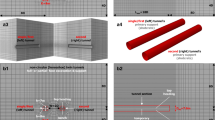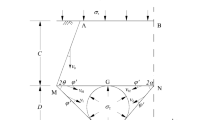Abstract
Prediction of displacements and lining stresses in underground openings represents a challenging task. The main reason is primarily related to the complexity of this ground–structure interaction problem and secondly to the difficulties in obtaining a reliable geotechnical characterisation of the soil or the rock. In any case, especially when class A predictions fail in forecasting the system behaviour, performing class B or C predictions, which rely on a higher level of knowledge of the surrounding ground, can represent a useful resource for identifying and reducing model deficiencies. The case study presented in this paper deals with the construction works of twin-tube shallow tunnels excavated in a stiff and fine-grained deposit. The work initially focuses on the ground parameter calibration against experimental data, which together with the choice of an appropriate constitutive model plays a major role in the assessment of tunnelling-induced deformations. Since two-dimensional analyses imply initial assumptions to take into account the effect of the 3D excavation, three-dimensional finite element analyses were preferred. Comparisons between monitoring data and results of numerical simulations are provided. The available field data include displacements and deformation measurements regarding both the ground and tunnel lining.























Similar content being viewed by others
References
Addenbrooke T, Potts D (2001) Twin tunnel interaction: surface and subsurface effects. Int J Geomech 1(2):249–271. doi:10.1061/(ASCE)1532-3641
Anagnostou G (2008) The effect of tunnel advance rate on the surface settlements. In: 12th International Conference of IACMAG, Goa, India
Augarde CE, Burd HJ (2001) Three-dimensional finite element analysis of lined tunnels. Int J Numer Anal Methods Geomech 25:243–262
Baguelin F (1978) The pressuremeter and foundation engineering. Trans Tech Publications, Clausthal
Benz T (2007) Small-strain stiffness of soils and its numerical consequences. Univ. Stuttgart, Inst. f. Geotechnik, Stuttgart
Brinkgreve RBJ, Bakker KJ, Bonnier PG (2006) The relevance of small-strain soil stiffness in numerical simulation of excavation and tunnelling projects. In: Proceedings of the 6th European Conference on Numerical Methods in Geotechnical Engineering—Numerical Methods in Geotechnical Engineering, p 133–139
Brinkgreve RBJ, Engine E, Swolfs WM (2013) Plaxis 3D 213 user manual. Plaxis bv, The Netherlands
Brinkgreve RBJ, Kumarswamy S, Swolfs WM, Waterman D, Chesaru A, Bonnier PG, Haxaire A (2015) Paxis 2D 2015 user manual. Plaxis bv, Netherlands
Buselli F, Graziani A, Lieto S, Rotonda T (2013) Observations from monitoring of tunnel excavations in clayey silt. World Tunnel Congress 2013, Taylor & Francis, pp 2078–2085
D’Elia B (2006) Esperienze sul comportamento di alti fronti di scavo. Riv Ital Geotech 2:12–48
Do N-A, Dias D, Oreste P, Djeran-Maigre I (2014) Three-dimensional numerical simulation of a mechanized twin tunnels in soft ground. Tunn Undergr Space Technol 42:40–51. doi:10.1016/j.tust.2014.02.001
Fargnoli V, Boldini D, Amorosi A (2015) Twin tunnel excavation in coarse grained soils: observations and numerical back-predictions under free field conditions and in presence of a surface structure. Tunn Undergr Space Technol 49:454–469
Fillibeck J, Vogt N (2012) Prediction of tunnel-induced settlements in soft ground. Parameters 1:T2
Franzius J, Potts D (2005) Influence of mesh geometry on three-dimensional finite-element analysis of tunnel excavation. Int J Geomech 5(3):256–266. doi:10.1061/(ASCE)1532-3641
Galavi V, Schweiger HF (2010) Nonlocal multilaminate model for strain softening analysis. Int J Geomech 10:30–44
Galli G, Grimaldi A, Leonardi A (2004) Three-dimensional modelling of tunnel excavation and lining. Comput Geotech 31:171–183. doi:10.1016/j.compgeo.2004.02.003
Hardin BO, Black WL (1969) Closure on vibration modulus of normally consolidated clay. Proc of ASCE 95:1531–1537
Jamiolkowski M, Lancellotta R, Lo Presti DCF (1994) Remarks on the stiffness at small strains of six Italian clays. Proceedings of the International Symposium, 2. Sapporo, Japan, 12–14 September 1994, pp 817–836
Janin JP, Dias D, Emeriault F, Kastner R, Le Bissonnais H, Guilloux A (2015) Numerical back-analysis of the southern Toulon tunnel measurements: a comparison of 3D and 2D approaches. Eng Geol 195:42–52. doi:10.1016/j.enggeo.2015.04.028
Karakus M, Ozsan A, Başarir H (2007) Finite element analysis for the twin metro tunnel constructed in Ankara Clay, Turkey. Bull Eng Geol Environ 66:71–79. doi:10.1007/s10064-006-0056-z
Katzenbach R, Breth H, (1981) Nonlinear 3-D analysis for NATM in Frankfurt Clay. In: Proceedings of the International Conference on Soil Mechanics and Foundation Engineering, 10th
Lade P (2005) Overview of constitutive models for soils. In: Calibration of constitutive models. American Society of Civil Engineers, ASCE, pp 1–34. doi:10.1061/40786(165)1
Lambe TW (1973) Predictions in soil engineering. Géotechnique 23:151–202. doi:10.1680/geot.1973.23.2.151
Lunardi P (2008) Design and construction of tunnels: analysis of controlled deformations in Rock and Soil (ADECO-RS). Springer Science & Business Media
Möller SC (2006) Tunnel induced settlements and structural forces in linings. Univ. Stuttgart, Inst. f. Geotechnik, Stuttgart
Monaco C, Tortorici L, Nicolich R, Cernobori L, Costa M (1996) From collisional to rifted basins: an example from the southern Calabrian arc (Italy). Tectonophysics 266:233–249
Negro A, Queiroz PIB (2000) Prediction and performance: a review of numerical analyses for tunnels. Geotech Asp Undergr Constr Soft Ground 409–418
Ng CWW, Lee KM, Tang DKW (2004) Three-dimensional numerical investigations of new Austrian tunnelling method (NATM) twin tunnel interactions. Can Geotech J 41:523–539. doi:10.1139/t04-008
Schanz T, Vermeer PA, Bonnier PG (1999) The hardening soil model: formulation and verification. Beyond 2000 Comput Geotech 281–296
Schweiger HF (2008) The role of advanced constitutive models in geotechnical engineering. Geomech Tunn 1:336–344. doi:10.1002/geot.200800033
Segato D, Scarpelli G (2006) Morphological effects on settlements induced by shallow tunnelling. In: Numerical methods in geotechnical engineering: Sixth European Conference on Numerical Methods in Geotechnical Engineering (Graz, Austria, 6–8 Sept 2006), p 299
Segato D, Scarpelli G, Fruzzetti VME, Ruggeri P, Vita A, Paternesi A (2015) Excavation works in stiff jointed clay material: examples from the Trubi formation, southern Italy. Landslides 12:721–730. doi:10.1007/s10346-014-0505-x
Shibuya S, Hwang, SC, Mitachi, T (1997) Elastic shear modulus of soft clays from shear wave velocity measurement. Geotechnique 47:593–601
Svoboda T, Masin D (2011) Comparison of displacement field predicted by 2D and 3D finite element modelling of shallow NATM tunnels in clays. Geotechnik 34:115–126
Vardanega P, Bolton M (2013) Stiffness of clays and silts: normalizing shear modulus and shear strain. J Geotech Geoenviron Eng 139:1575–1589. doi:10.1061/(ASCE)GT.1943-5606.0000887
Vermeer PA, Bonnier PG, Möller SC (2002) On a smart use of 3D-FEM in tunnelling. In: Proceeding of Eighth International Symposium on Numerical Models in Geomechanics, p 361–366
Vucetic M, Dobry R (1991) Effect of soil plasticity on cyclic response. J Geotech Eng 117:89–107
Wongsaroj J, Soga K, Mair RJ (2007) Modelling of long-term ground response to tunnelling under St James’s Park, London. Géotechnique 57:75–90
Yeo CH, Hou LF, Chee TS, Hasegawa O, Suzuki H, Shinji M (2009) Three dimensional numerical modelling of a NATM tunnel. Int J JCRM 5:33–38
Author information
Authors and Affiliations
Corresponding author
Rights and permissions
About this article
Cite this article
Paternesi, A., Schweiger, H.F. & Scarpelli, G. Parameter Calibration and Numerical Analysis of Twin Shallow Tunnels. Rock Mech Rock Eng 50, 1243–1262 (2017). https://doi.org/10.1007/s00603-016-1152-4
Received:
Accepted:
Published:
Issue Date:
DOI: https://doi.org/10.1007/s00603-016-1152-4




